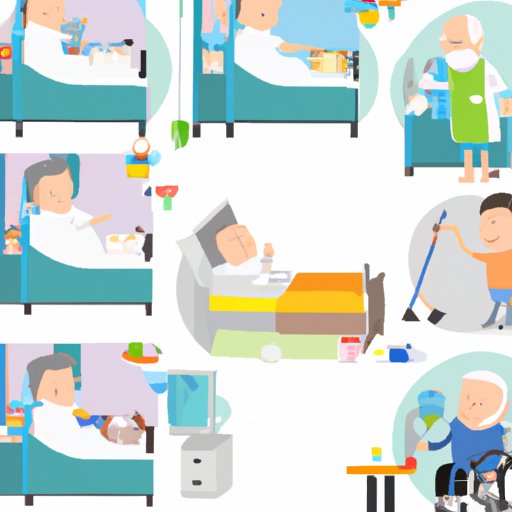Introduction
Caring for a bedridden patient at home is not an easy task. A bedridden patient is someone who is confined to bed due to a medical condition or disability. It can be a difficult and exhausting process for both the patient and family caregiver, but it is possible to maintain a safe and comfortable environment for the patient. This article will provide helpful advice on how to care for a bedridden patient at home, including establishing a daily routine, providing proper nutrition, maintaining good hygiene, planning activities, and monitoring the patient’s health.
Establish a Daily Routine
Having a regular daily routine is beneficial for both the patient and caregiver. A routine helps to provide structure and consistency to the patient’s day, which can help them feel more secure and in control. It can also help them to better manage their time, as well as reduce stress and anxiety levels. Here are some steps to help establish a daily routine:
- Schedule meals and snacks at the same times each day.
- Plan for breaks throughout the day for rest and relaxation.
- Incorporate light physical activity, such as stretching or range of motion exercises.
- Set aside time for leisure activities, such as reading, watching television, listening to music, or playing games.
- Establish a regular sleep schedule.
Provide Proper Nutrition
Proper nutrition is essential for bedridden patients. They may have difficulty eating due to lack of appetite or difficulty swallowing. They may also be at risk for nutrient deficiencies due to inadequate intake. It is important to ensure that the patient is receiving adequate amounts of calories, protein, fat, vitamins, and minerals. Meal planning should take into account the patient’s individual needs, such as food allergies, dietary restrictions, and preferences. Here are some meal planning considerations:
- Include a variety of nutritious foods, such as fruits, vegetables, lean proteins, whole grains, low-fat dairy, and healthy fats.
- Choose foods that are high in fiber, such as fruits, vegetables, beans, and whole grains.
- Limit foods that are high in sugar, salt, and saturated fat.
- Avoid processed and pre-packaged foods if possible.
- Encourage the patient to drink plenty of fluids throughout the day.
Maintain Good Hygiene
Good hygiene is important for bedridden patients. Poor hygiene can lead to skin breakdown and infection. It is important to keep the patient clean and comfortable. Here are some tips for maintaining good hygiene:
- Bathe the patient regularly, using warm water and mild soap. Use a washcloth or sponge to gently cleanse the skin.
- Brush the patient’s teeth and gums twice a day with a soft toothbrush and fluoride toothpaste.
- Change bedding and clothing regularly to prevent bacteria buildup.
- Keep nails trimmed and free of dirt and debris.
- Apply moisturizer to the skin to prevent dryness and cracking.
Plan Activities
It is important to plan activities for the bedridden patient to help promote physical and mental health. This may include physical activities, such as range of motion exercises or stretching, as well as activities that engage the mind, such as reading, writing, puzzles, or board games. It is important to consider the patient’s physical limitations when selecting activities. For example, if the patient has difficulty sitting up, choose activities that can be done lying down.
Monitor Health
It is important to monitor the patient’s health closely. Watch for any changes in symptoms or behavior, and contact the doctor immediately if anything seems unusual. Be sure to keep a record of the patient’s vital signs, such as temperature, blood pressure, and pulse rate. This information can be useful for tracking changes over time and identifying any potential health issues.
Conclusion
Caring for a bedridden patient at home can be a challenging experience. However, with proper planning and preparation, it is possible to create a safe and comfortable environment for the patient. Establishing a daily routine, providing proper nutrition, maintaining good hygiene, planning activities, and monitoring the patient’s health are all important aspects of home care for a bedridden patient. With patience, understanding, and compassion, you can provide the care and support your loved one needs during this difficult time.
(Note: Is this article not meeting your expectations? Do you have knowledge or insights to share? Unlock new opportunities and expand your reach by joining our authors team. Click Registration to join us and share your expertise with our readers.)
